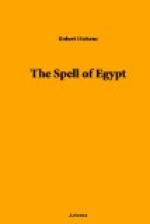And the sunset waned, and the afterglow flamed and faded, and the clear, soft African night fell. The pilgrims who day by day visit the Sphinx, like the bird, had gone back to Cairo. They had come, as the bird had come; as those who have conquered Egypt came; as the Greeks came, Alexander of Macedon, and the Ptolemies; as the Romans came; as the Mamelukes, the Turks, the French, the English came.
They had come—and gone.
And that enormous face, with the stains of stormy red still adhering to its cheeks, grew dark as the darkness closed in, turned brown as a fellah’s face, as the face of that fellah who whispered his secret in the sphinx’s ear, but learnt no secret in return; turned black almost as a Nubian’s face. The night accentuated its appearance of terrible repose, of super-human indifference to whatever might befall. In the night I seemed to hear the footsteps of the dead—of all the dead warriors and the steeds they rode, defiling over the sand before the unconquerable thing they perhaps thought that they had conquered. At last the footsteps died away. There was a silence. Then, coming down from the Great Pyramid, surely I heard the light patter of a donkey’s feet. They went to the Sphinx and ceased. The silence was profound. And I remembered the legend that Mary, Joseph, and the Holy Child once halted here on their long journey, and that Mary laid the tired Christ between the paws of the Sphinx to sleep. Yet even of the Christ the soul within that body could take no heed at all.
It is, I think, one of the most astounding facts in the history of man that a man was able to contain within his mind, to conceive, the conception of the Sphinx. That he could carry it out in the stone is amazing. But how much more amazing it is that before there was the Sphinx he was able to see it with his imagination! One may criticize the Sphinx. One may say impertinent things that are true about it: that seen from behind at a distance its head looks like an enormous mushroom growing in the sand, that its cheeks are swelled inordinately, that its thick-lipped mouth is legal, that from certain places it bears a resemblance to a prize bull-dog. All this does not matter at all. What does matter is that into the conception and execution of the Sphinx has been poured a supreme imaginative power. He who created it looked beyond Egypt, beyond the life of man. He grasped the conception of Eternity, and realized the nothingness of Time, and he rendered it in stone.




